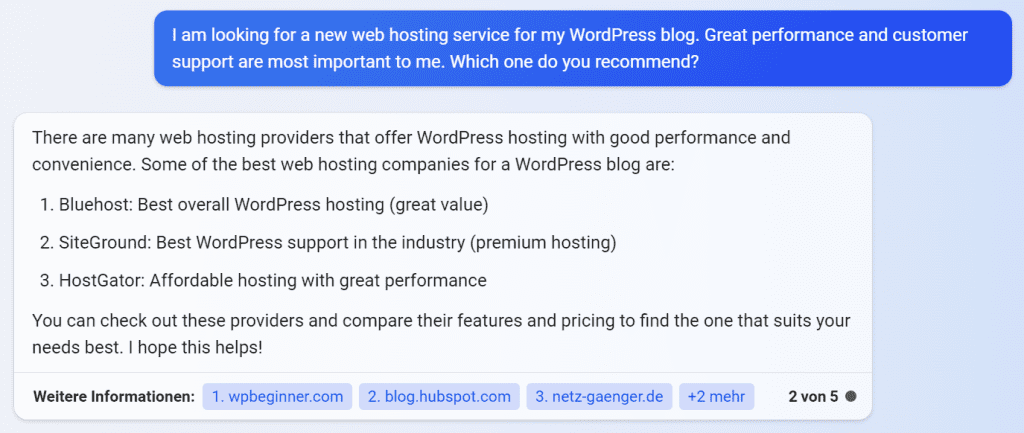by Sven Winnefeld, Strategy Director
What is Generative AI Optimization (GAIO)? And why should not only marketers, but also PR professionals take notice?
Generative AI Optimization (GAIO) is a new, largely still hypothetical marketing discipline, similar to Search Engine Optimization (SEO). Until now at Hotwire, we’ve called this discipline ‘Chatbot Optimization,’ but moving forward we’ve adopted the term ‘GAIO’ ([ˈgaːjo]), a term proposed by the German SEO expert Philipp Kloeckner.
- GAIO, similar to SEO, aims to enhance brand visibility within LLMs such as ChatGPT and Bing Chat.
- Unlike traditional SEO, GAIO emphasizes brand mentions over backlinks, marking a shift in digital marketing tactics.
- Challenges include convincing users of chat-based search benefits and refining the GAIO toolkit to influence brand presence in LLM responses.
- Early adoption of GAIO could offer strategic advantages amid the evolving digital marketing landscape.
GAIO revolves around the notion of how companies can ensure that their brand and products feature prominently in widely used Large Language Models (LLMs) such as ChatGPT, Bing Chat and Google Bard. Figuring this out is important, as these models could potentially influence many purchasing decisions in the future – and are likely already doing so to an increased extent. For example: If you ask Bing Chat about the best toaster for a dorm kitchen, the AI will recommend a device from Philips. If you pretend to be the CEO of a fast-growing startup and ask for help in selecting a suitable ERP software, it might suggest SAP Business One. But how are these recommendations generated?
Brand mentions replace backlinks
Bing Chat always considers the context that is provided by the user. For example, it’ll suggest a different laptop to a gamer than to a graphic designer. The AI cites secondary sources such as trade media, blogs or comparison sites that inform its recommendations. Manufacturer pages, on the other hand, are almost never used as a source.
This upends the established rules of search engine optimization, at least to some extent. In traditional web search, backlinks continue to be one of the most important criteria for relevance. Whoever can collect more high-quality links has a clear advantage in the competition for the highest rankings in the search results. In chat-based search, the situation seems to be different. In this case, the focus is no longer on backlinks, but on brand mentions. It’s no longer crucial who links to my website, but where I’m mentioned and what is being said about me. (Great news for PR consultants!) At the same time, one’s own website loses importance if search engine users are less frequently redirected there.
Putting theory into practice
As GAIO continues to gain traction as a new emerging discipline, there are two hurdles to overcome:
- A large amount of users need to be convinced about the benefits of chat-based search.
- We need to figure out what the GAIO toolkit will look like.
In order to attract and retain a sufficient number of users, AI models need to significantly improve – especially when it comes to product recommendations and product-related questions. While Bing Chat is already good at providing context-based and even comprehensibly justified recommendations, Google Bard currently only provides brief product lists without justifications or source citations, offering no added value to the user. In the instance of ChatGPT, it offers an enormous amount of advice and context but refuses to recommend specific products or brands. This is because the training data for this LLM currently only extends up to September 2021, unlike Bard and Bing Chat which can access live data from the internet. However, if the pace of technology advancement continues as it has over the past few months, these issues could soon be resolved.

The GAIO toolkit
The use-cases where AI helps us gain visibility into trends and behaviors, and pull value and insight from data are ever-expanding. Hotwire has been ahead of this trend with PR measurement and comms. But how will Generative AI Optimization continue to expand? The most immediate problem for companies is the lack of visibility. Currently, they don’t know how often and in what context their products and brands are mentioned in the answers of LLMs. What questions are asked and how frequently? Do the answers include outdated or inaccurate information? In which contexts are certain products recommended, and what are the sources of these recommendations? Are competitors mentioned more often? To answer these questions, new tools are needed that will need to function similarly to popular SEO tools, such as Semrush or Sistrix.
Once this visibility is established, GAIO specialists must then learn to understand which factors influence a company’s presence in the LLMs’ responses. This refers to the parameters that are known in search engine optimization as ranking factors. So far, Bing Chat has been the primary source of insight into how responses are formulated, as it links to information sources beneath its responses. For ChatGPT, the training data underlying the model and their weighting are known – a good starting point for further research.
As soon as we understand these variables, we can try to influence them. That’s when the real optimization begins. A relatively simple tactic could involve systematically evaluating which websites the LLMs regularly use as sources for certain product categories. Subsequently, brands could attempt to secure placements of their own products and messages on these pages.
In order to be able to understand whether these measures would actually make a difference, it’s necessary to measure their success. So far, all the prerequisites for this are missing because the providers of the LLMs don’t provide any insight and statistics. However, this is expected to change in the next few weeks: Microsoft wants to take the first step by integrating Bing Chat Reports into its Webmaster Tools. In addition, Bing Chat is to be specifically identified in the referrer data so that website owners can understand how many visitors the chatbot directs to their sites. From this point on, it will be possible to draw initial conclusions and better understand the relevance of Generative AI in the customer journey.
How hypothetical is GAIO?
Depending on the rising user adoption of Generative AI for product research, Generative AI Optimization holds promise far beyond theory. As this trend unfolds, brands will increasingly seek strategies to enhance their presence in LLM responses. Yet, like other rapidly evolving digital arenas, early movers stand to gain a significant advantage here. Embracing GAIO now could be pivotal for maximizing brand visibility and competitiveness in the dynamic digital landscape.
Want to leverage the power of GAIO for your brand? Reach out to learn more!
